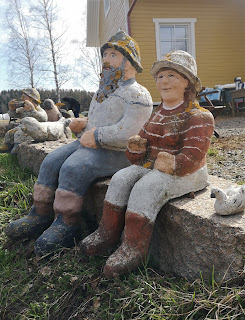 |
pictures courtesy of
Heli Kallio-Kauppinen and Raija Kallioinen |
The photo above very well summarizes what the following post is essentially about, namely a mill (symbolized by the grindstone), two sculptures (representing an extensive display of sculpted creations) and all of this surrounded by a beautiful landscape.
This landscape is depicted in the two images below, where the two sculpted characters, lined up along the edge of the forest, are overlooking the Vaalimaanjoki river in south-east Finland.
Welcome to Sylvia Hauhia's art environment, which is very special, not only because of the hundreds of attractive and captivating sculptures the site includes, but also because of the way they are arranged in a very natural way, both in the landscape and in a variety of buildings.
Life and works
Sylvi Hauhia, born in 1928, grew up in Hauhia, a small village that is part of the municipality of Miehikkälä, with about 1800 inhabitants, located in south-east Finland not far from the border between Finland and Russia.
Sylvi was 11 years old when the family was evacuated after Russia at the end of November 1939
invaded Finland without a declaration of war. The
Winter War, as the battle is called in Finland, ended in mid-March 1940 and Finland had to give up parts of the country. The
Salpalinja, the 1200 km defense line along Finland's eastern border, built in the years 1940/44, bisects the municipality of Miehikkälä, which also houses a
museum dedicated to the line
Returned to Hauhia, as a teenager Sylvi already felt attracted to making small-scale sculptures from clay.
In 1953, when she was in her mid-20s and had married, she and her husband moved into a house near the mill of Hauhia, located near a rapids named Hauhiankoski (Hauhian Rapids) in the Vaalimaanjoki river, just outside the village. Her husband was a farmer and Sylvi assisted him in caring for the cattle.
Currently (2022) in her 90s, Sylvi Hauhia has lived in this area for some seventy years, steadily working on her collection of sculptures, which now includes some thousand creations.
Initially Sylvi mainly made small sculptures, as can be seen in the surrounding images, with above a scene of a group of people dancing, perhaps a memory of her wedding or a comparable festivity.
These and similar scenes fill the shelves of a barn on the premises of the mill, near Sylvi's home, an exposition space opened in the summer of 2021 and referred to as Gallery Sylvi.
The small-scale creations, mainly made of clay, have a benign, sympathetic appearance and are often based on the artist's personal experiences. Sylvi collected the necessary clay by paddling in the rapids and scraping the material from the bottom with her own hands.
Real handicraft indeed ....

After living in the house near the mill for some time, Sylvi Hauhia started making large-sized sculptures, as the following series of images shows.
These sculptures, mostly made of cement, currently are partly set up in the outdoor space of the mill and can be freely visited.
Another part, some hundred sculptures, is exhibited in the courtyard of the mill and in the residential building near the mill, where the collection can be visited (freely) during opening hours.
The images show that these creations also mainly radiate a good-natured atmosphere, with mostly everyday characters in everyday situations (Sylvi and her husband are the couple shown in the image below right).
The Hauhia mill
The Hauhia watermill dates from 1882 and was created thanks to the carpenter Petter Lundgren and the farmers Emmanuel Hauhia and Erkki Hauhia. In August 1885 the mill was bought by Sylvester Manikin, who became a respected miller whose company contributed to the food supply in the area.
In the 1920s the mill was equipped with a sawmill and later an electricity generator was installed, which supplied the village with electricity. This machinery is now obsolete and no longer works
In January 2020, Markku Hauhia, a son of Sylvi Hauhia, bought the mill and surroundings, and as part of an environmental project to improve the river basin, the mill was refurbished.
Rearranging the site
Since that purchase, the Hauhia family has worked to give the area around the mill a new allure, promoting the site as an artistic and recreational facility.
The barn at Sylvi's house, in former days a cow house, but currently no more used as such,
reopened in 2021 as Galleria Sylvi Hauhia.
A small coffee shop was installed with some tables and chairs, making a small terrace available to the visitors. Not far from the mill, bicycles and rowing boats can be rented.
The outdoor arrangement of the large sculptures was adapted to the new character of the site.
In January 2022, the Regional Advisory Council for Environmental Policy
announced that the
Hauhiankosken (Hauhian Rapids) environmental project, which also included the renovation of the mill, was the best environmental project of 2021.
 |
the three young men in the image above are sons of Sylvi Hauhia, one of the three is Markku Hauhia
|
Documentation
*
Entry on the website
ITE taide
*
Entry about the village of Hauhia on the website of the municipality of Miehikkälä
Video
* Video on the Facebook page of Hauhian Mily
Sylvi Hauhia
Sculptures in and around a watermill and gallery
Hauhiantie Road 340
49700 village of Hauhia, municipality of Miehikkälä, region Southern Finland, Finland
visitors welcome (a donation is appreciated)
info about opening hours of the gallery and the coffee shop
on the Facebook-page of the site











magnifique mème matiere que moi henk
ReplyDelete